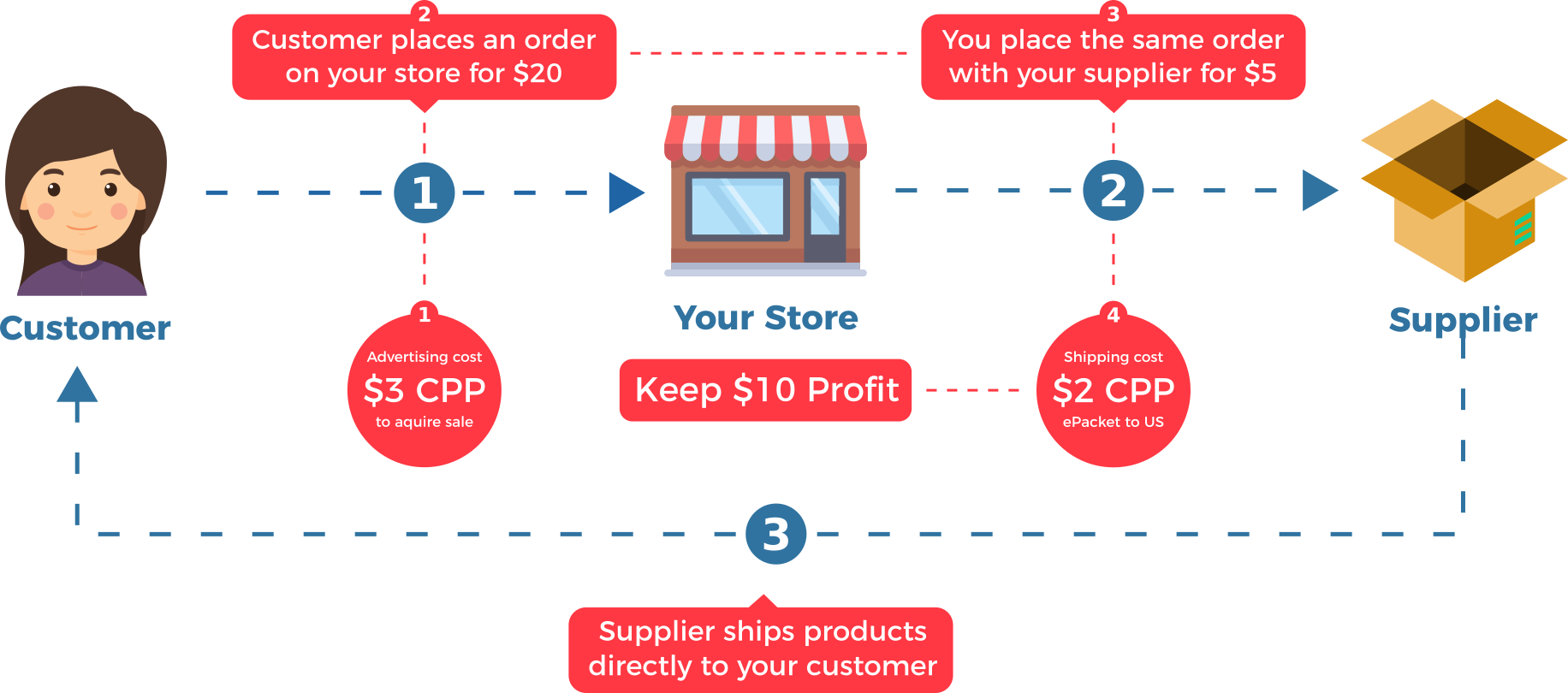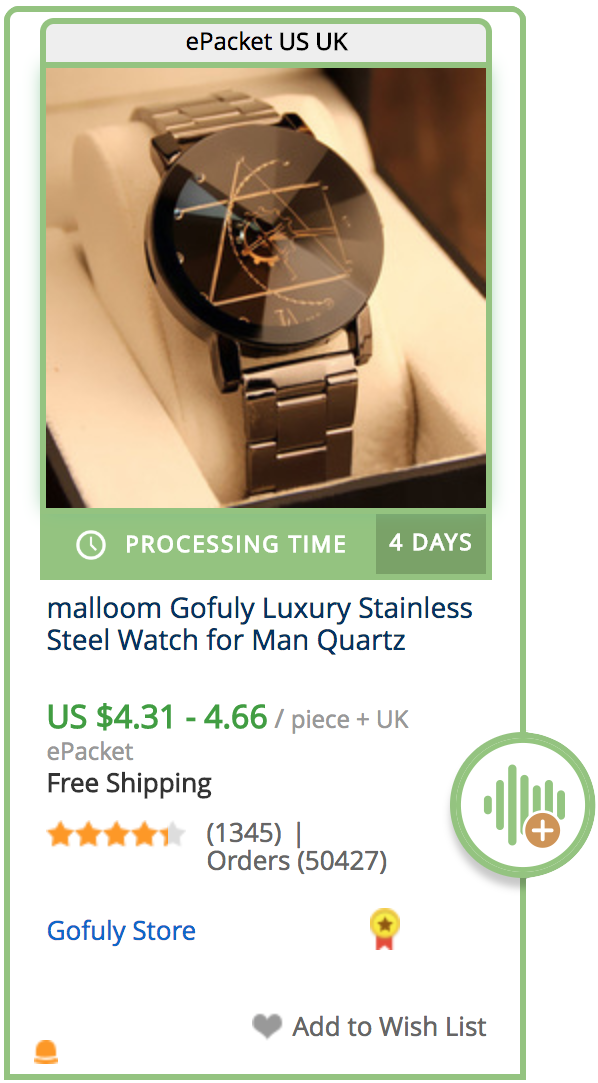How to Start a Drop-Shipping Store
Starting a Drop-Shipping Store is a great way to access the huge marketplace of e-commerce. It enables you to open an online store selling products without having to buy and stock anything upfront.
A simple way to explain the process of drop-shipping is that you become a middleman, connecting customers with the supplier by listing their products on your store. As far as the customers are aware though, it’s you that is providing the product. This allows you to build a brand and reputation based around your own store.
You first need to find a ‘winning’ product from a wholesale supplier, manufacturer or reseller and list it on your own store for a marked-up price. You then drive traffic to the product page by marketing on platforms such as Google, Facebook and Instagram. When a customer places an order on your store, you in-turn place the same order with your supplier and they will ship it out directly to the customer. The price at which you sell the product, minus the cost from your supplier and ad costs required to generate that sale, will be your profit. At this point, you’ve not had to handle any stock, package or ship anything yourself and you’ll have hopefully made a realistic profit of around 10-20%.
The image below shows the drop-shipping method and how it results in you making money.

It may sound simple, and for the most part, it is, but don’t confuse simple with easy. To run a successful drop-shipping store requires hard work and dedication and should be treated as a real business from day one. So if you’re just looking for a little extra cash to make in your spare time, I wouldn’t really recommend this method. Drop-shipping is going to be more suited to you if you are looking to build a real business that can eventually replace your job, and I’d recommend starting out alongside your current full or part-time job, until the money it provides is enough to replace your 9-5 income.
How do I start?
The quickest and easiest way to create a drop-shipping store is to sign up with an e-commerce platform like Shopify who actually have a 14-day free trial, so you can even have your store set-up and ready to go before having to pay anything. It’s fairly very easy to set-up your store. In as little as a day, it can be ready to go with a functioning checkout and all other tools you need to run an online store, as well as the ability to integrate a tonne of other apps and software to help generate sales.
Firstly, you need a source of products. The most widely used supplier for this purpose is AliExpress, which is a Chinese wholesale website where most suppliers are happy to drop-ship. Products from here are very cheap so easy to price-up and there are methods to ensure you only order good quality products from reputable suppliers.
Shipping from suppliers in China does take longer than people are used to with companies like Amazon spoiling customers with 1-2 day shipping, however, you’ll find that most people purchasing from you won’t mind this as long as you’re upfront about it as customers will often be buying an item from you that they’ve not seen anywhere else.
This is where product selection comes in. It’s important to spend time researching the right products for your store and selling items that aren’t as readily available in high-street stores helps.
It’s also worth mentioning that because the majority of shoppers aren’t bothered about shopping around for the best price, as long as your items are priced reasonably, they’ll not think twice before ordering from your store. That said, it’s important to make sure your store-front shows that you’re a real and trustworthy business with a professional store design that has an optimal customer experience including the right layout, product descriptions etc. There’s plenty of tutorials about this online and I’ll also be putting some out on my YouTube channel soon.
As an alternative to drop-shipping products from AliExpress or the like, you could open a print-on-demand store (POD), or even a combination of the two. POD is essentially drop-shipping for custom printed apparel and other household items such as cushions, duvets, mousepads and other printable items. This is a slightly less travelled route for internetpreneurs and potentially a better one for longevity. However, I won’t be going into detail about this particular route here. If you’d like to find out more check out my YouTube channel.
What makes drop-shipping such a great business model is the ability to automate most of it and eventually outsource the rest which gives it huge scalability. You can, therefore, build a business that provides a generous income whilst leaving you the time to also enjoy the benefits of your hard work.
The most important part of automation is the process of importing products into your store and fulfilling orders. Both of these can be done through an app called Dropified. There are some alternatives, the main one being Oberlo, however, I switched to Dropified myself after learning of it’s wider range of features and honestly wouldn’t switch back. It’s also free up to 200 orders per month. The software integrates with your Shopify store and allows you to easily import a product directly from AliExpress with the click of a button.
Further to that, as soon as a customer purchases from your store, the order details are synced to Dropified where you can simply click one button to have the order processed completely automatically. If you’ve never processed any orders using Shopify and AliExpress before without the help of this software then you’ll not appreciate what huge game changer it is. But trust me. You won’t do without it.
 Another important function of Dropified is the AliExpress overlay which displays useful information about shipping and costs that otherwise aren’t visible whilst browsing. This allows you to more easily find eligible products. It’s worth noting that if you’re running a POD store as described above, then having Dropified isn’t necessary as the POD company you choose to go with most likely have an app that integrates with Shopify to automate order fulfilment.
Another important function of Dropified is the AliExpress overlay which displays useful information about shipping and costs that otherwise aren’t visible whilst browsing. This allows you to more easily find eligible products. It’s worth noting that if you’re running a POD store as described above, then having Dropified isn’t necessary as the POD company you choose to go with most likely have an app that integrates with Shopify to automate order fulfilment.
Getting your store set-up is fairly simple however getting it looking professional and setting it apart from other stores requires much more fine tuning and in-depth knowledge. If it’s your first time using Shopify then I recommend you watch some tutorials on YouTube.
Theme choice is one of the first things to consider and is very important. There are free themes supplied with your Shopify subscription and Brooklyn is the go-to theme for most beginners however I would recommend spending a little money and getting Shoptimized. This is a pre-built highly customisable theme, with many conversion apps built into it which saves you a tonne of money on monthly app subscriptions that you’d otherwise likely have to add at a later date. It also has a dedicated support team who will help with coding and any changes that you may want to make to tweak the theme to your liking. Out of the box, the theme looks much more professional than any of the free Shopify themes in terms of resembling a large scale e-commerce store like TopShop or American Apparel. It’s highly versatile with lots of customisation options which allow you to alter the theme without any coding knowledge. Other things that you’ll need to do is set up your payment provider, shipping costs and apps and once your store is ready to go with some products loaded you’ll need to start driving traffic.
How do you make sales?
In order to drive traffic to your store the fastest and most successful method is by using paid advertising. Most people teaching drop-shipping will tell you to learn Facebook advertising and that is definitely an option but at the time of writing, Facebook is making a lot of changes to its advertising platform that isn’t particularly good for drop-shipping. So I would recommend trying out Google Adwords as well as Facebook.
Both platforms have their benefits and require some degree of learning to use effectively but Google Adwords is definitely the easier of the two. Also, because less Shopify stores are currently advertising on Google right now, you may find that there’s less competition. Either way, you’ll have to test and see which one gets you better results.
Instagram and Snapchat also have advertising platforms that could be worthwhile testing and Pinterest also has been shown to produce some amazing results in terms of ROI. If you can grow a channel on Facebook or Instagram quickly then using that audience can be very beneficial. The key to having a product that blows up and takes your store into space is creating viral ads so they play a huge role in the success of your store and are a learning experience themselves.
I recommend running video ads pretty much all the time simply because they are proven to get more clicks. If you want to create ‘quick and dirty’ video ads then you could try Clipman. It’s an online video ad creator that generates a video by grabbing the images from a URL you provide and allowing you to choose a template and add some text and music. It really doesn’t get much easier. Bear in mind they are very basic however so if you want to produce something more elegant or upmarket than consider subscribing to Animoto. It’s a much more powerful video ad creator that gives you more flexibility and design input.
I’ll briefly touch on the concept of the ‘back-end’ of drop-shipping. Just like affiliate marketing, you want to be building a list whilst you operate your store so capturing an email address from as many visitors as possible is vital. This allows you to follow-up with them if you didn’t make the sale and encourage them to purchase at a later time and to establish contact with customers thanking them and offering future promotions to encourage repeat purchasing. By doing this effectively you will find that your back-end sales can often account for as much as half of your total revenue or more.
This means you need an email marketing software linked to your Shopify store. I’d recommend GetResponse. It’s a market leader in email marketing and has a great easy to use interface with strong automation features. There are both free and paid alternatives such as MailChimp or ActiveCampaign but having used these I prefer GetResponse for its price and usability. You can encourage users to join your mailing list by using an app such as Wheelio, an interactive pop-up that offers customers a potential prize at the spin of a wheel. That’s just an overview. Email marketing is a whole topic unto itself so that’s for another post.
How much does it cost?
So how much would you need to get started? There’s no exact figure for this of course. It will always differ from person to person but you will spend money in three areas; start-up costs, overheads and marketing.
Start-up costs are minimal. Just a domain name (I get all mine from NameCheap), the Shoptimized theme if you decide to go for it and a logo if you don’t want to do it yourself. So £20-100.
Your monthly overheads which would include your Shopify subscription, Dropified (free up to 200 orders a month), GetResponse and any other Shopify apps that you require will likely be between £50-200 per month depending on your set-up and choice of software.
Lastly, marketing costs is where you will spend the most money. You could try free methods of marketing, however, doing it the free way, will of course be much more time intensive to gain attention and take far longer to start bringing in any sales. Ad costs really could be anything and it’s up to you as to how fast you want to test products and what your budget is. If we take the $5 per day ad method as an example, if you were to test 1 product a day, with 3-5 audiences it would cost up to $15-25 a day or $450-750 per month.
This might sound like a scary figure but bear in mind once you’re ad-sets are optimised and reaching the right audience you should be making back at least three times this much. That said, be prepared to ‘lose’ some money when starting out as part of the learning phase and also in finding the right audience for each product. Over time you’ll get better at hitting the right audience off the mark but research also plays a key part in this.
Being honest, if you think that you will have to go down the free traffic route when starting out, then I would probably suggest that drop-shipping isn’t for you right now. Having some money to act as a safety net it really recommended. Instead, try matched betting or affiliate marketing in order to build up some capital.
